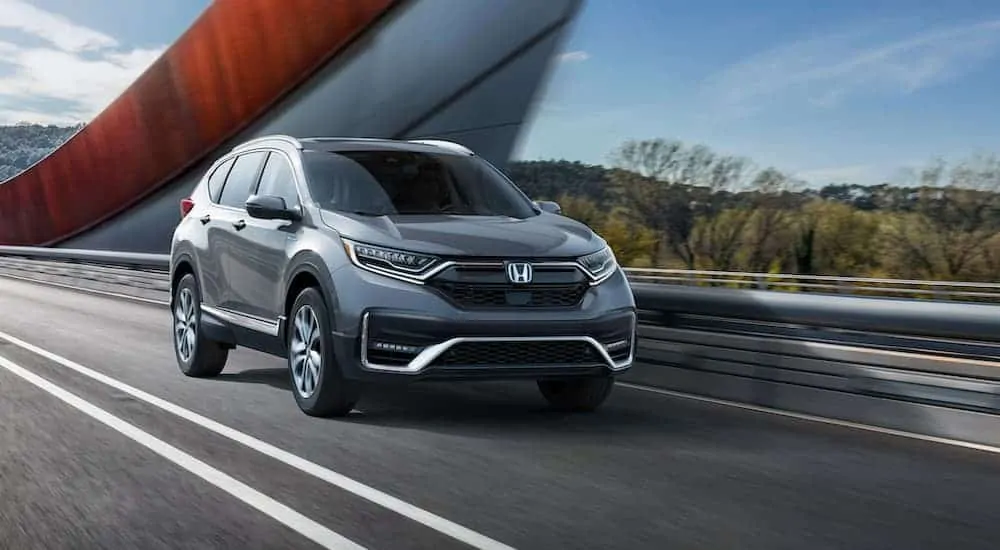The Honda CR-V has been around as long as almost anyone can remember and has been getting better every year since its inception. The 2020 model year is no exception, as Honda rolled out a new Hybrid model that bumps fuel economy dramatically to 40 MPG in the city and 35 MPG on the highway. That makes the already comfortable and flexible family hauler into an efficient beast and adds some nice low-end torque along the way.
The 2020 Honda CR-V Hybrid is an excellent vehicle, there are no two ways about it, but it’s not the best in its segment. The competition, especially from Toyota, is fierce and has also been improving year-over-year to the point that it’s a virtual, hybrid arms race. That’s good for consumers, but not necessarily a great thing for Honda, as they were later to the game than Toyota. Let’s take a look at what makes the CR-V tick and dig deeper into what makes it a great vehicle that falls just short of the Toyota RAV4.
Performance
The CR-V Hybrid isn’t any faster than the standard version, but it feels more planted on the road. That’s due in part to the Hybrid’s firmer suspension, which was put in place to accommodate the weight of extra batteries on the floor. Even so, the ride is comfortable and compliant, and remains so even when road conditions turn rough. My Touring trim test vehicle came with 19-inch wheels that didn’t spoil the ride, either.
After spending time in quite a few hybrids over the years, a problem that often seems to rear its head is the “handoff” between gas and electric powertrains. When the vehicle is traveling slowly, it runs on its electric engine, but over a certain speed––usually around 20 mph or so––it needs to switch to the gas engine to continue accelerating. It’s that moment that gives many hybrid systems trouble, as there’s stuttering and an awkward over-revving of the gas engine that happens when it needs to take over. That’s not the case with the CR-V Hybrid. Acceleration is smooth from the moment the pedal is pressed. Noise from the gas engine’s engagement is minimal, and there’s no shuddering or jerkiness.

Tech
Infotainment is a soft spot for Honda these days. All trims except for the base LX get Apple CarPlay and Android Auto, but any action that requires the use of the system’s default software will cause headaches. It’s got the right feature set and the right setup, but it’s laggy and not as responsive as the interfaces in many other vehicles in the CR-V’s class. Settings and controls are sometimes buried a few menu levels deep, which can make it difficult to find the right part of the system to interact with when the vehicle is in motion. Even so, the Touring trim comes with navigation and an excellent audio system that fills the cabin with rich sound.
While the Honda falls short on entertainment tech, it excels on standard safety gear. The CR-V comes standard with automatic emergency braking, pedestrian detection, lane keeping assist, lane departure warnings, and adaptive cruise control. The Touring trim I tested came with collision mitigation braking, parking sensors, rain-sensing windshield wipers, blind spot monitors, and rear cross-traffic alerts.
Safety Scores
All of that standard tech was good enough for the Insurance Institute for Highway Safety to award the CR-V with a Top Safety Pick designation for the 2020 model year. That included Good scores in all crash test categories and superior scores for both vehicle-to-vehicle and vehicle-to-pedestrian crash prevention systems. The National Highway Traffic Safety Administration gave the 2020 CR-V five stars overall.
Interior and Comfort
The CR-V Hybrid’s interior is spacious and looks great, even with faux-wood trim in the Touring version. A floating center control stack houses the push-button gear shifter and the infotainment screen, which is mounted high enough on the dash to be easily viewed from almost any angle. The doors and dash are accented with the “wood”, nice plastics, and metal-look materials. Most surfaces are soft-touch and come covered in materials to make them more pleasing to both the eye and the touch.
The CR-V Hybrid’s front seats are supremely comfortable. They manage to maintain that comfort while also offering decent bolstering and support. Head and legroom are both generous in the front row, and the large windows up front make outward visibility excellent in nearly all directions.
The second row is roomy enough for kids in large car seats, though drivers over six feet tall may find that rear-facing seats need to ride on the passenger side. Kids in booster seats will have no issue climbing in and will fit behind either seat. Loading car seats is made easy by the CR-V’s low-ish ride height and large rear door openings. My wife, who is five feet tall, usually struggles to help our three-year-old daughter into anything taller than a skateboard, but she was able to load and buckle the kiddo without much of a challenge.
The standard CR-V leads its class in cargo space, but the batteries cut into the Hybrid’s cargo hold. It’s still got plenty of room to hold large suitcases, the family dog, and nearly anything else you can think to stow back there, and the folding rear seats open up even more space. That said, with the Hybrid, you lose the adjustable load floor because of where the batteries are located, and more bad news comes in the form of an eliminated spare tire, which was also nixed to make room for the battery.
The bottom line here is this: If you love the CR-V but just can’t get around the standard model’s fuel economy, you’ll be happy with the 2020 Honda CR-V Hybrid. It’s more responsive than the standard model and is as refined as any other hybrid on the road. Even so, Toyota’s hybrid systems have pushed its RAV4 to new heights, and their power and muscular stance may be more attractive to some buyers, especially for the money. If you can wait out the months-long backlog for a RAV4 Prime, it will likely end up being the best vehicle in the segment.





